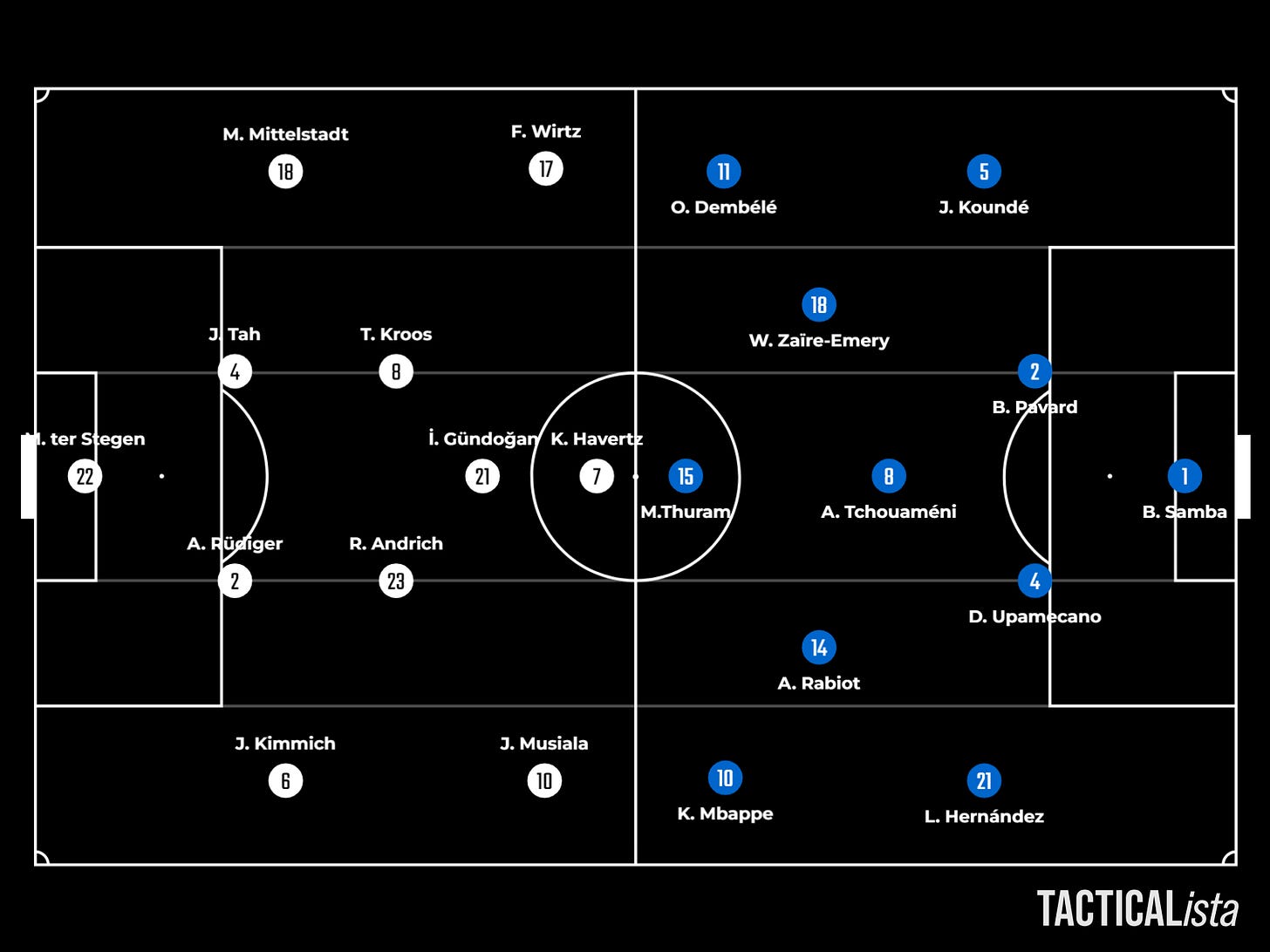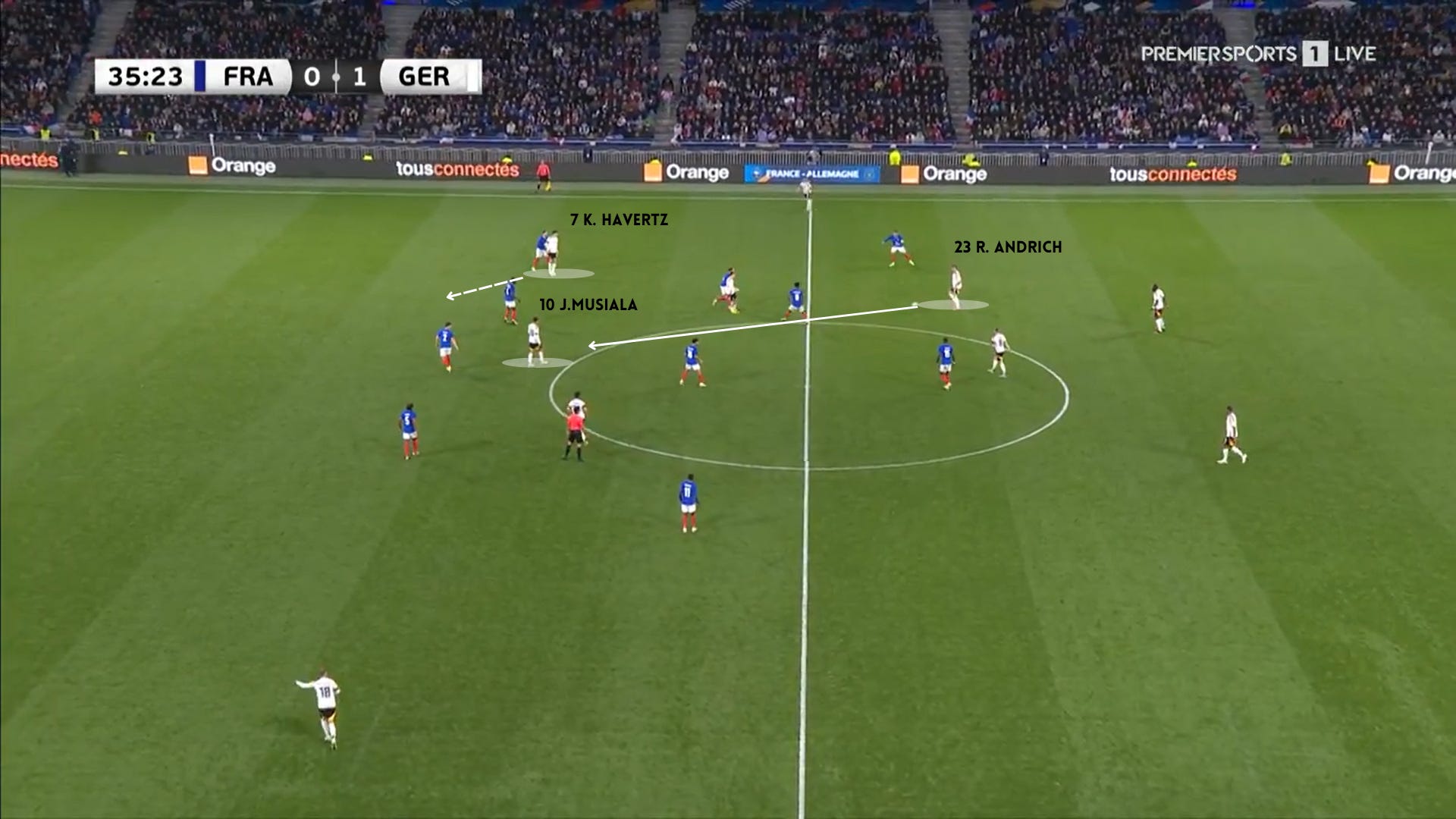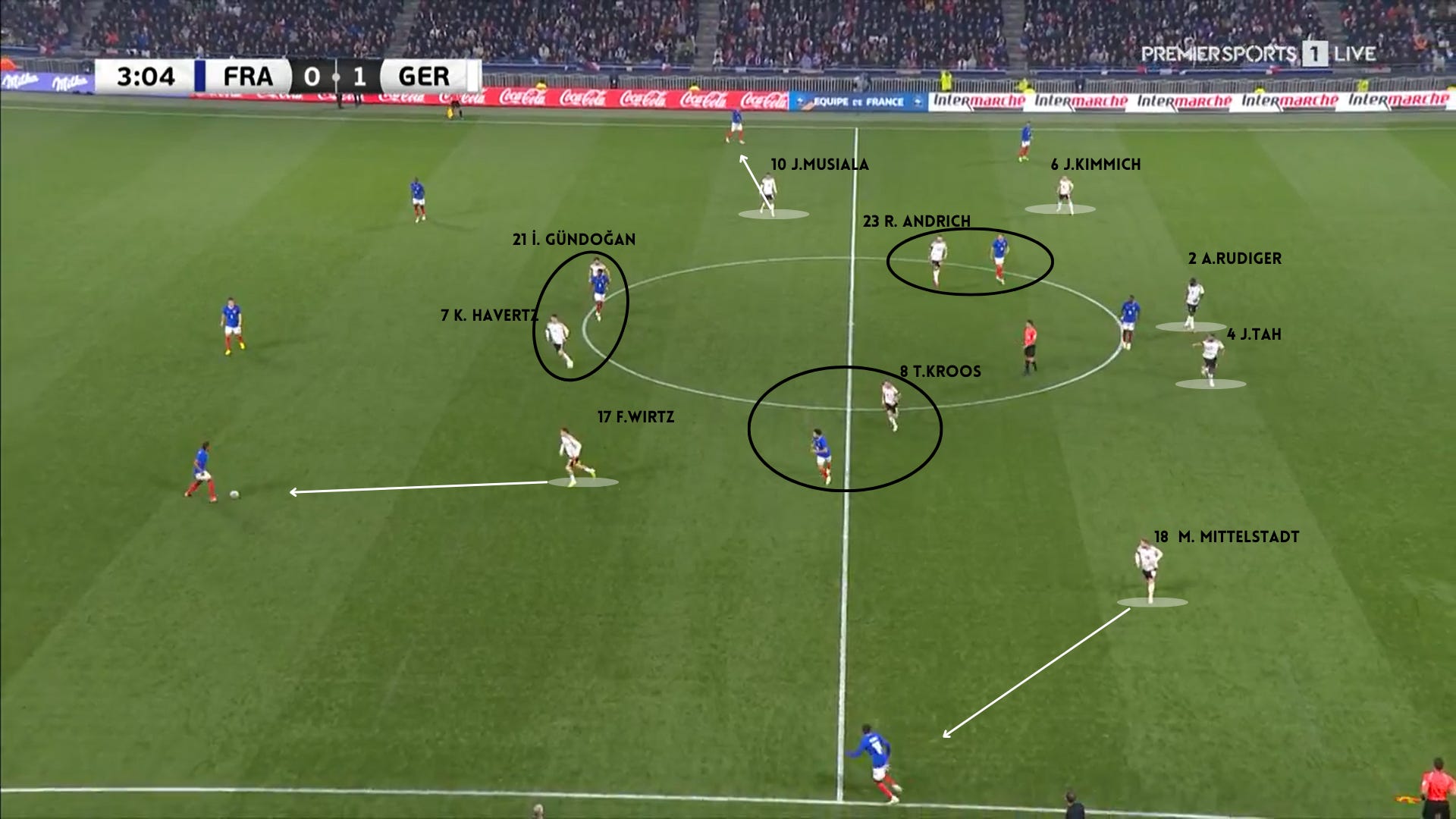France - Germany: Tactical Analysis (0-2)
Julian Nagelsmann and his boys displayed a solid performance at Groupama Stadium when they secured a win against the French national team in a friendly game. The Germans sent a statement that they would be a tough opponent to deal with in the Euros 24 in front of their crowds.
The clash saw the return of Toni Kroos to fulfill international duties after he retired from the Euros 2020.
How the managers saw it
Julian Nagelsmann was satisfied with the performance of his players: “Big compliment to the team, that was very, very good. The first 25 minutes were very good. Maybe we could have scored one more goal.” He added: “We improved again in the second half and had three or four really good chances. Even when we made subs, Deniz Undav and Maxi Mittelstädt had two great chances. In the end I’m very, very satisfied.”
On the contrary, Didier Deschamps wasn’t thrilled about his team, as he said: “The Germans did things better than us. In terms of commitment and aggression, we were below.”
Starting Line-ups
Germany In Possession:
Since the kick-off, it was clear that Julian Nagelsmann's concept for the game was to stretch France vertically and find spaces between the lines for Musiala and Wirtz to wreak havoc.
Toni Kroos's body orientation towards Ter Stegen, and his intention to play the ball back, triggered France's second line to go in a group with the front players to press Germany in their half. However, Kroo’s instant body re-orientation in the opposite sense, and Germany's front four attacking the space between the lines, put six French players out of the game leaving acres of space to be exploited.
In a short amount of time, Kroos recognized Florian Wirtz who was going to pull the trigger announcing Mannschaft's opening goal. Julian Nagelsmann confirmed that his team had been training for such patterns to apply them in the game: “The kick-off was planned that way, it was excellently prepared by our set piece coach Mads Buttgereit and then was executed well.”
Julian Nagelsmann's minimum width concept was transparent in German players’ positions. It was usually Toni Kroos who dropped on the left next to Tah and Rudiger to benefit from his distribution (long and short passes). Germany preferred to cluster the play on the right side for the sake of the two following reasons:
Taking advantage of long balls to players running behind France's back-line:
With the 4-4-2 mid-block and narrow compact shape, the French national team made it impossible for the Germans to play centrally on the floor. However, the Mannschaft were able to find solutions.
Havertz's intention to drag Pavard or Upamecano with him, Wirtz on the left inside channel pining Koundé and Gundogan coming deep pulling Tchouaméni out, drove Musiala to successfully sneak in behind Rabiot’s back and run down the right inside channel to get Toni Kroos long pass.
Freeing the left-back (M. Mittelstadt) on the left side:
Germany intended to stretch France's lines as much as possible. Therefore, they exploited France 4-2-3-1 out of possession by Gundogan dropping deep to drag Tchouaméni with him in the right inside channel.
Adding to that, the moment Rudiger showed signs of playing the long ball, the front three (Musiala, Havertz, and Wirtz) were tasked with starting runs vertically towards France's back line. The process resulted in expanding the hosts’ lines, offering Kai Havertz time and distance to receive the ball and lay it off to Wirtz, who tucked inside the vacated space by Gundogan between the lines and switched the ball to Mittelstadt. The latter took advantage of Musiala's diagonal run which provided him with spaces to play.
The use of relative width:
If Toni Kroos didn’t drop to the back line, Germany lined up with a 4-2-3-1 shape, played narrower and relative to other players’ references. The fullbacks provided the team with the necessary width based on the ball, teammates, spaces, and French position.
Nagelsmann is one of the advocates of minimum width as he likes to overload and combine in central channels to break France lines from one part and to help the team on the counter-press to regain the ball back as much as possible on the other.
The Germans were composed on the ball, they were willing to return it to the back, starting another process,s keeping the vertical and direct play. So, a breaking line pass from the back to one of the front players—usually Gundogan— (central combinations) was an alternative to progress in possession.
In the same regard, Wirtz and Musiala were one of the German outlets. Julian Nagelsmann gave them the license to roam freely and trusted their abilities to interpret the game. Both were offering themselves as options to progress high up the pitch. They built a great sense of understanding each other's positions and movements, especially in the right inside channel when Wirtz came deep receiving and passing on open body situation to Musiala.
In deeper positions, Florian Wirtz was a trap to drag French midfielders out of their positions, opening spaces between the hosts' lines for German forward players to obtain the ball. For instance, Wirtz dropping to the midfield and laying the ball off to Andrich pulled out Rabiot with him, and stretched France’s lines. Musiala took advantage of the situation to receive the ball from Andrich, turn around and pass the ball to Havertz who was attacking the box.
In addition, Germany were patient in possession going usually to the right side with Gundogan, Musiala, and Andrich shifting across to interchange between each other. What made them look smooth is their fluid rotations creating numerical matches on the wings to explore options of penetration through the wide channels.
Overloads:
The Germans overloaded the right side to isolate the left back on the other side and progress with the ball.
Julian Nagelsmann’s concept centered around the idea of the left back receiving the ball freely, drifting inside diagonally to push the French block backward and find the right back in the right half-space. Kimmich —operating in those areas— aims to find runners (Musiala) behind France's backline and attack the box supported by Kai Havertz's movements to evacuate the space.
Germany's second goal:
Jamal Musiala: "I feel good with Wirtz on and off the pitch. We talk to each other a lot and we always look at where one of us is when the other starts dribbling."
"The connection between us gets even better with every game."
Jamal Musiala's statement was crystal clear in Havertz’s goal. Once Florian Wirtz took on Koundé and Zaïre-Emery, Musiala started running diagonally to attack the space vacated by Havertz drawing Upamecano's attention. Wirtz played the ball over to put Musiala face-to-face with the goalkeeper.
Germany Out of possession:
France built their attacks with a 4-2-3-1 shape, while Germany pressed them in a 4-4-2 mid-block. Julian Nagelsmann’s boys allowed the French backline to circulate the ball between each other, preventing the central progression. Kroos and Andrich man-marked Emery and Rabiot respectively whereas Tchouaméni was outnumbered by Havertz and Gundogan.
German fullbacks took charge of France's wingers (Dembélé, Mbappé). Nagelsmann set a pressing trap on the touchlines which was obvious on his players’ body orientation toward the wide channels.
For instance, Koundé has one option on the right wing. Once the ball was played, Mittelsdat and Wirtz jumped over him, cut all passing lanes off, and turned over.
Julian Nagelsmann and his boys performed a solid tactical game where they dismantled France's lines using the concept of relative width, central progression, and combinations, relying on the half-spaces where Musiala and Wirtz operated.
It still has for Germany room to develop in terms of coherence and cohesion between players, especially with the return of Toni Kroos. It’s apparent that Germany under Julian Nagelsmann will be a top-notch team that will compete for the trophy in the Euros 24.
If you’re enjoying what we are producing—whether it’s an analysis, scouting, or opinion—Please subscribe, leave a comment, and drop a like. It helps us know that people out there value the work, and it boosts us on the Substack algorithms.
“Sharing knowledge is not about giving people something, or getting something from them. That is only valid for information sharing. Sharing knowledge occurs when people are genuinely interested in helping one another develop new capacities for action; it is about creating learning processes.”~Peter Senge


























